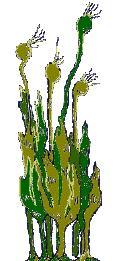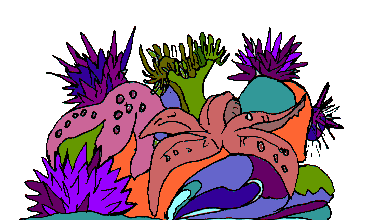| Back home | To West Indies | to bottom | To scenic Big Sur | To Underwater page |
| Back home | To West Indies | to bottom | To scenic Big Sur | To Underwater page |
Although I spent much more time in California, I did little (none to be exact) S.C.U.B.A. diving there.This was on account of several reasons:
There was a wide variety of Sea Mammals that frequented areas that were very close to shore:There were Whales which when migrating passed very close to shore; a frequent tourist attraction.
There was a multitude of Seals which are of the suborder Pinnepedia (I luckily cannot draw them) but they are very "cute" described as having "A torpedo-like body, a dog-like head, and four webbed feet..." (flippers- webbed feet) which causes them to have an ackward waddle when on land.
All sea mammals breathe air and many genuses can maneuver on land; however the whale cannot survive on land, hence the term "Beached Whale"; this is on account of their massive weight which essentially suffocates them. In other words, they suffocate on land since in water the water pressure is constant and they are able to exhale and inhale (This has to do with Bernoulli's Law on pressure.)(NB I may need to change this part.) The flippers of the whale can be equated to arms in the human (or the forpaws of dogs, etc.)Although they are (as mentioned) a tourist attraction in California, they are in many cultures hunted for their "Blubber", their bones, thus putting some species on the endangered list.The same is true of seals which are also hunted in certain areas. Seals are very friendly and intelligent; they are a common inhabitant of large aquariums ("SeaWorld").A variety of the seal is the Sea Lion and the Sea Elephant
The Sea Lion is a variety of "Eared" seal (Seals can be divided depending on whether or not they are eared)The Sea Lion is often mistakedly referred to as a seal. They can be more aggressive (especially the males) but they also are intelligent and often can be seen at public aquariums.
A very fascinating species of the seal is the Sea Elephant . These are enourmous mammals. The male Sea Elephant has a "proboscis" (a trunk) which is the size of a small seal! ...And that is just the nose, so you can only imagine the large size these creatures attain.(F.Y.I. Killer Whales are a type of whale, however the "whale Shark" is a very placid species of shark (that only eats plankton))
Of course there were Dolphins and Porpoises but to write about these fascinating sea mammals would take an entire book to do them justice...

A kelp forest can be very dangerous to the S.C.U.B.A. diver in that the very massive and long stems tend to entangle the diver.Kelp can grow up to 1500 feet (?meters?)The illustration is meant to depict the "floats" that are air-filled "vescicles".The kelp plant is firmly anchored on the ocean floor.
In many countries Kelp (or dried Seaweed) is eaten for example,with sushi!Also byproducts of the plant are often used as a gelatin like base (Agar)
Kelp was often found washed ashore on the California beaches.
The beaches off the coast of California were much more rugged and rough. The rocks had jagged edges; and some beaches were made entirely of Pebbles!

The sharp contrast to the peacful beaches of the West Indies was mostly due to the action of the waves being much more powerful off the Pacific.(Pebble Beach) Click HOMETo return to home page. Click HEREto see the West Indies. Click TOPto return to top of this page. Click HereTo learn more about tidepools. Click HEREFor scenic Big Sur. Click HereFor some Info on S.C.U.B.A. Click HEREFor a little extra. Click HEREto send me email!